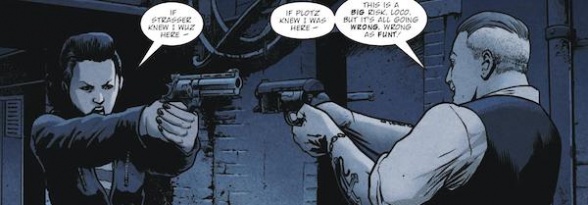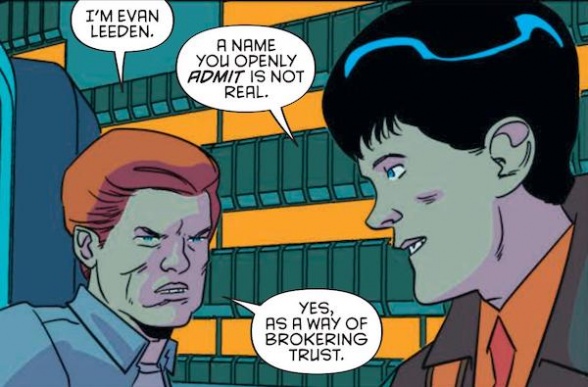
Welcome, Earthlets, to Multiver-City One, our “2000 AD” weekly review column! Every Wednesday we examine the latest offerings from Tharg and the droids over at Rebellion/2000 AD, the galaxy’s leading producers of Thrill-Power entertainment. Let’s get right to it!

THIS WEEK IN 2000AD

Judge Dredd: Special Relationship: 04
Credits: Rob Williams (script), Patric Goddard (art), Quinton Winter (colors), Annie Parkhouse (letters)
Greg Lincoln: As readers, we know the whole plot here is an opportunist hack and that many someones are getting played. That said, it’s hard to watch it happening, even panel by panel. It’s especially hard knowing it’s a Sov-Block plot. Rob Williams almost makes good arguments in guise of the character Mr Vinun, who we almost have to assume is a Sov agent. Well maybe not really good, but they sound good if you are the mark in this sting. That talking heads scene is far less compelling than the appearance of the woman who called herself Domino that follows it and what her appearance may portend. This all feels like a bit of preamble though; the final pages of this week take us back to the present and the clusterfuck Dredd’s assault becomes in the wake of the Britt-Cit forces ambush.
The real cranking up of the stakes this week is all due to the art. The deeply craggy face of Vinun is full of character and just oozes malice in those talking heads scenes. The way that Patric Goddard draws him and Domino both give great impressions of who they are or who they choose to appear as. They are both great spy story staples in they way that they are designed, though appearances can always be misleading. What is not misleading in the art is the dire situation Dredd is in. He and his crew got played by their Britt-Cit counterparts. The pacing of the ambush leads the action right up till the shooting starts. They did a great job using closeups and shadowed shots to get both the Judges and us to that point when the big guns go off. It’s not a stellar chapter because some of it feels staged, but it’s a solid story that leaves you needing next week’s chapter.

Skip Tracer: Valhalla Part Four
Credits: James Peaty (script), Paul Marshall (art), Dylan Teague (colours), Simon Bowland(letters)
Michael Mazzacane: Thus far I’ve been onboard with the character centered storytelling of “Skip Tracer”, not every strip could be just pure character and no plot, but the creative team have done a good job of balancing the two and fusing them together. Until this strip, which is a storytelling necessity but one that feels hollow for how melodramatically it pushes the plot forward.
When something happens to a character be it good or bad or in between the reader is supposed to feel something. As Nolan’s cranky old friend sacrifices himself to the horde of zombies so that his teammates may escape, I’m supposed to feel something. And I didn’t. Not that Paul Marshall didn’t try and get that emotion out of me the juxtaposition on page for cross cutting between Nolan escaping and the zombies devouring is horrifyingly beautiful. Dylan Teague builds the whole page contrasting warm and cool colors.
Maybe it was the use of the splash page, which is an effective piece of composition. The gun burst slowly being swallowed into the gapping may of encroaching blackness. That is normally the poor use of page budget I wouldn’t like. And I still don’t love it even if it makes sense for selling the sudden and inevitable nature of the sequence. Everything is the kinda masculine melodrama you would expect but it didn’t grab me.
That shallow, hollow, feeling is exasperated by the twist in the final page about the nature of Valhalla. It’s a good twist that raises questions and doesn’t undo the death but still feels like it undermines it.
This strip is a plot mover which isn’t bad. They tend to happen in this structure but they don’t have to be this perfunctory.
Continued below
Dexter Bulletopia Chapter 10: Malice in Plunderland Part 4
Credits: Dan Abnett (script), Tazio Bettin (art), Matt Soffe (colors) Annie Parkhouse (letters)
Matthew Blair Everything was going so well for Dexter and his crew. They had appraised the situation they were in, figured out what was going on and how fix it, and the rival mobs were actually believing everything they were telling them.
Unfortunately, it wouldn’t be a very good story if anything ever went to plan, and it turns out that two of the lieutenants in the rival gangs have their suspicions and plans that involve Dexter’s untimely demise.
Writer Dan Abnett makes the two narrating gangsters the stars of the show in “Dexter Bulletopia Chapter 10 Part 4” and it’s a lot of fun. The usual wordplay between narration from panel to panel is still there while the motivations and backstory of each of the narrators is fleshed out in a way that makes sense and keeps the story moving. There’s a very real sense of familiarity between the two and a sense that they were good friends in their early lives, it’s just that years of working for rival gangs has the annoying habit of making them just a bit paranoid and distrustful of each other. It’s a friendship that makes sense, but it’s still shaky enough for interesting things to develop.
We’ve sung the praises of Tazio Bettin’s artwork in “Dexter Bulletopia Chapter 10 Part 4” enough to know that the art does a great job of telling the story and all that is left is to find and highlight the little things. In this part of the story Bettin has a nice bit of artistic symmetry when the leaders of each gang are assassinated. Bettin does a great job of giving the story a sense of forward momentum that keeps the pace high and the reader scanning the page quickly, waiting to see what happens next.
“Dexter Bulletopia Chapter 10 Part 4” is quite the setback for Dexter and his pals, but it’s a setback that makes a lot of sense and offers a new and interesting challenge that appears difficult while leaving just a bit of hope that Dexter will get out of this alive.

Brink: Mercury Retrograde Part 21
Credits: Dan Abnett (script), INJ Culbard (art), Simon Bowland (letters)
Brian Salvatore: The toothy grin that seemed like it was, perhaps, a little detached from reality is revealed to actually be a toothy grin of subterfuge. “Evan Leeden” has finally revealed who he really is. Well, kind of. He’s a deep cover plant from an unnamed agency who wants Maz to break a story. The story isn’t even all that important; Leeden needs Maz’s story to allow some cooperation between the police and his agency. In exchange for greasing the wheels of cooperative justice, Leeden will give Maz the roadmap he needs to properly arrange all of the pieces so that his story lands.
On one hand, we are supposed to be excited for Maz, because he’s getting some serious assistance from someone in the know. But on the other, this could all be, yet another, layer of misdirection and misinformation. And that nervous uncertainty is what INJ Culbard does so well in this chapter. Maz and Leeden never really look at each other, both to look innocent from the outside, but also to show the reader just how foggy this whole thing is. Between Dan Abnett’s purposely vague script and Culbard’s artwork that rarely draws your eye to any real center, the chapter feels a bit off-balance.
That’s because it is working.
With ‘Mercury Retrograde’ seemingly coming to a conclusion sooner than later, Abnett an Culbard are continuing to obfuscate essential pieces of information, while also allowing the reader to get closer and closer to the truth. While this cat and mouse game can’t go on forever, it is still reading as enjoyable, despite the strip going through prolonged periods of spinning its wheels.

Jaegir: Ferox Part Two
Credits: Gordon Rennie (Script), Simon Coleby (Art), Len O’Grady (Colors), Jim Campbell (Letters)
Christopher Egan: Violence is right in our face this week. Even more-so than the premiere, part two is is nasty and uncomfortable. Without being gratuitous, the fighting and discomfort of the scenes are all over this chapter. The creative team isn’t playing it safe, but they are using a restrained hand, which is welcome. It allows itself to be viewed and accepted by a broader audience without being too broad.
It continues to be a look at the layered and darker side of a war that maybe the combatants don’t fully understand. It’s gritty and upsetting in the right way. All of this is done at a more surface level, but it works. Its pace is its greatest asset. In, out, and leaves you wanting more.






